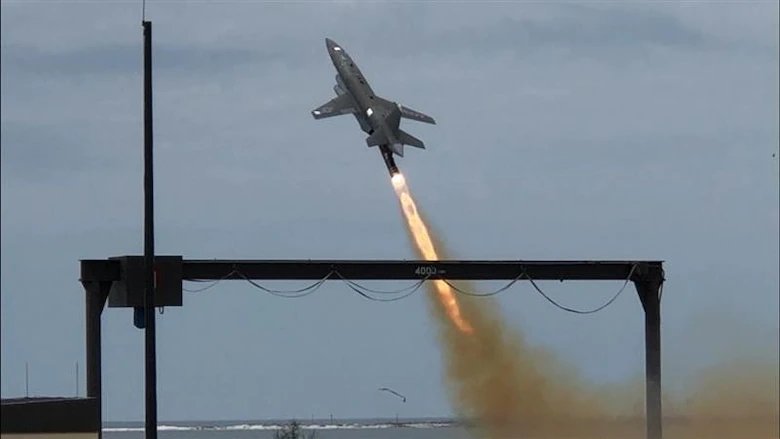According to information published by U.S. Air Force on May 6, 2021, the Skyborg leadership team conducted a 2 hour and 10-minute flight test of the Skyborg autonomy core system, or ACS, aboard a Kratos UTAP-22 tactical unmanned vehicle at Tyndall Air Force Base, Florida.
Follow Air Recognition on Google News at this link
 The Skyborg autonomy core system launches aboard a Kratos UTAP-22 tactical unmanned vehicle at Tyndall Air Force Base, Florida. (Picture source: U.S. Air Force)
The Skyborg autonomy core system launches aboard a Kratos UTAP-22 tactical unmanned vehicle at Tyndall Air Force Base, Florida. (Picture source: U.S. Air Force)
Termed Milestone 1 of the Autonomous Attritable Aircraft Experimentation, or AAAx, campaign, the ACS performed a series of foundational behaviors necessary to characterize safe system operation. The ACS demonstrated basic aviation capabilities and responded to navigational commands, while reacting to geo-fences, adhering to aircraft flight envelopes, and demonstrating coordinated maneuvering. It was monitored from both airborne and ground command and control stations.
The Skyborg Vanguard team is a unique relationship that pairs Brig. Gen. Dale White, program executive officer for fighters and advanced aircraft as the Skyborg PEO, and Brig. Gen. Heather Pringle, Air Force Research Laboratory commander, as the Skyborg technology executive officers. The 96th Test Wing, under the leadership of Brig. Gen. Scott Cain serves as the executing agent for these test missions.
Milestone 1 is the first step in testing the ACS and begins a sequence of experimentation events planned over the next several months.
The 96th Test Wing is well-positioned to integrate and test emerging technologies like autonomy on various platforms (aircraft and weapons), and has provided critical infrastructure support and test expertise to Skyborg. Milestone 1 was the first time an active autonomy capability was demonstrated on an Air Force test range, and is a first step to integrating these aircraft into a complex operational environment.
Skyborg is an autonomy-focused capability that will enable the Air Force to operate and sustain low-cost, teamed aircraft that can thwart adversaries with quick, decisive actions in contested environments. The program will enable airborne combat mass by building a transferable autonomy foundation for a family of layered, unmanned air vehicles. This foundation will deliver unmatched combat capability per dollar by lowering the barriers to entry for industry and allowing continuous hardware and software innovation in acquisition, fielding and sustainment of critical mission systems. During this effort, AFRL will prototype a suite of autonomy and unmanned system technologies equipped with capabilities that can support a range of Air Force missions.
To fast-track this game-changing capability, the U.S. Air Force designated Skyborg as one of three Vanguard programs in 2019. These priority initiatives integrate several technology components across multiple domains to create complex, multidisciplinary solutions. Marked by an enterprise-wide commitment, Vanguards deliver advanced capabilities that transform future operations with cutting-edge technologies. As autonomy technology matures, Skyborg will bring cutting-edge capabilities to the fight at a faster pace and lower cost.
Based upon the proven success of the U.S. Air Force BQM-167A aerial target, the Kratos Unmanned Tactical Aerial Platform (UTAP-22) provides the warfighter with an affordable, fighter-like unmanned aircraft capable of collaborative operations with manned assets in contested environments. With an operational ceiling of 50,000 feet and a top speed exceeding .9 Mach, the Kratos UTAP-22 high-performance design provides an unmanned partner/wingman to the warfighter.
The Kratos UTAP-22 approach allows flexibility in command and control architecture, ample payload capacity, and flexible vehicle signatures in a low cost system. Utilizing a minimal footprint rocket-assisted launch and precision parachute recovery, the Kratos UTAP-22 solution can operate in austere locations without a runway.
The versatile design of the Kratos UTAP-22 supports various mission requirements by accepting a wide array of internal and external payloads. The large, configurable auxiliary bays provide up to 8.5 cubic feet of payload volume. Additional payloads may be incorporated after a thorough review. Customer-furnished payloads may be considered for integration.
















